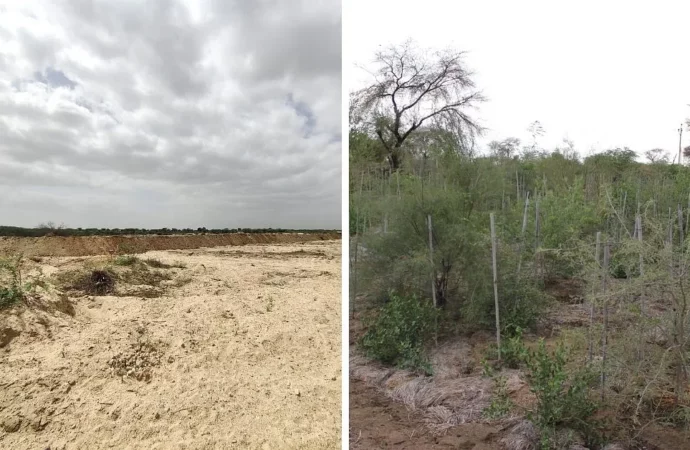Engineer Gaurav Gurjar along with Afforestt transformed highly saline and infertile land in the Rajasthan desert into a safe habitat for birds, animals and reptiles Khejri tree, also known as ghaf, was once found in abundance in Khejarli village and surrounding areas of Rajasthan. The tree has a historical significance as it led to the birth
Engineer Gaurav Gurjar along with Afforestt transformed highly saline and infertile land in the Rajasthan desert into a safe habitat for birds, animals and reptiles
Khejri tree, also known as ghaf, was once found in abundance in Khejarli village and surrounding areas of Rajasthan. The tree has a historical significance as it led to the birth of the famous Chipko movement, wherein the Bishnoi community fought to stop chopping them off.
In spite of their efforts, the landscape changed for multiple reasons, and today, the area wears a dry, barren look with the absence of local tree species that once thrived.
The striking difference is evident in the old folk literature and paintings, which describes the region flourishing with local flora and biodiversity. The art even depicts leopards hunting animals like deer and wild boar, among other bird species.
However, in 2017, when Gaurav Gurjar and his boss Shubhendu Sharma visited the area, all they could see were vast empty stretches of barren land with minimal shrubs and vegetation.
“All we could see were a pair of foxes running past us to their den. We found the land highly saline, and the area was infested with invasive species Prosopis juliflora,” he says.
However, Gaurav is trying to change the canvas for the better by rewilding and restoring the ecosystem to its original glory by planting khejri and other local species.
Forming An Oasis
The 32-year-old native of Jodhpur is an engineer who has chosen to dedicate his life to environmental causes. “I took electronics engineering for my specialisation but soon realised that it was not my cup of tea. The cause of environment protection was more alluring to me,” he tells The Professional Times.
During his graduation years, between 2009 and 2012, he explored options to work on environmental conservation with NGOs and organisations as a volunteer.
Over the years, he worked to create forests, conserve biodiversity and rescue snakes.
“What was planned to be a 10-day visit with an NGO in Chennai turned out to be a 1.5-month-long stint. During my stay, I also assisted research students for their work,” he says.
After finishing his graduation, Gaurav immersed himself entirely in the environmental sector, travelling across India and learning aspects of natural farming and sustainable architecture while working on multiple projects with experts in their respective fields.
“I travelled as a backpacker, bartered my skill and work, for food and shelter. I lived with the tribals learning how they followed a sustainable lifestyle using local resources, took lessons in building eco-friendly, earthquake-proof homes and restored forts.
I spent months with farmers of Maharashtra, Gujarat and South India who taught me natural and organic farming methods,” he says.
Gaurav then worked as a consultant for NDTV’s reality TV show – Godrej Green Champion, focussing on organic farming, mulching and other modern techniques.
Thereafter, he worked with NGO Swechha, which helped the Delhi government and the US Embassy plant eight mini urban forests.
In 2017, he joined Bengaluru-based Afforestt Pvt Ltd, which worked in multiple areas, such as creating Miyawaki forest, coordinating with the forest department during leopard and tiger census and preserving rare tree species on the verge of extinction.
Coincidentally, the organisation had adopted projects regarding research and development of barren terrain and saline lands of Anantapur in Karnataka and Peshawas in Jodhpur of Rajasthan, respectively.
He then moved from Bengaluru to Jodhpur to begin his work in restoring the land at Peshawas under the project Maruvan, a non-profit.
“Dr Sunil Nahar, who owned the 18-acre of a saline land patch and wanted it to be devoted for environmental conservation.
He wanted to revive the land and dedicate it for creating a safe habitat for deer and other wild animals in the vicinity,” he says.
He studied the area with Shubhendu and found it an difficult task to restore the land.
The flash floods and droughts faced by the Luni River flood plains had eroded the topsoil making it infertile.
The arid region had lost native tree species cover to erratic monsoons, extended droughts, flash floods and excess sand mining. The plants could barely survive, and the animals could not manage to feed around the plains,” he explains.
Counting to their woes, they did not have a roadmap to apprehend the biodiversity that earlier existed and steps to take for restoration.
“Growing a forest on fertile land is doable, but doing the same on barren land demands an innovative approach,” he notes.
Gaurav says his organisation decided to take up the challenge as an experimental lab to revive the landscape.
“We decided to research and survey to understand the original native forest and natural vegetation of the region.
Planting non-native plant species would not survive and prove hazardous for the environment. Therefore, it was imperative to specify and restore the local biodiversity,” the ecologist says.
He began conversing with villagers, taking notes about sacred groves that once existed in the region. The locals also introduced him to traditional painting and art forms. “
I studied the ancient paintings on the hardwood Khejri trees, old fort walls and referred to literature such as poems.
It gave me a sense of the types of trees, shrubs, grasses and wildlife that existed years ago in the Thar desert,” he says, adding, “I learned that the vegetation also worked as a barrier to stop desertification.”
He says, “It was evident that some tree species described in the ancient art and literature had disappeared.
The description of wildlife in pictures proved that the area had dense vegetation allowing animals to sustain and hunt in the bushes.”
Taking cues from his observations, he procured native tree species such as khejri, ingot, khair, kummat, khabar, kankera, peelu, arna, daabi and others.
Later, Gaurav took cues to source water from traditional water sources such as ponds, wells and lakes.
“We created a 3 acre wide 24-feet deep shallow pond to store rainwater and dug shadow wells adjacent to it.
The shallow wells work as a source of sweet water that percolates from the pond. however, if dug deeper, the pond water mixes with the saline groundwater making it redundant,” he says.
After fulfilling irrigation needs, he and his team members planted native species and used mulching methods to maintain moisture levels in the scorching desert sun.
“We implemented natural farming techniques and used jeevamrut, a mixture of cow dung, cow urine, gram flour, jaggery and organic matter for improving soil fertility,” he says.
Today, the 18-acre land is an oasis with green patches of vegetation ranging from shrubs, grasses, trees and others.
“They sustain without manual watering,” he says.
The land has attracted reptiles and snakes like vipers, cobra and animals like desert cats, leopards, white-footed desert fox, nilgai, wolves and hare. “We also have sightings of pheasants, fowls and weaver birds,” he says.
Initial signals of ecosystem restoration are already visible.
Citing an example, he says, “When we removed invasive plant species, the Dabda grass started growing naturally on the land.
The weaver birds use it to build nests, and since then the bird population has increased in the surroundings.
Moreover, the population of fox and wild boar has also increased.”
In 2020, Maruvan separated from Afforestt to become an independent entity.
Gaurav and his wife Varsha live on the land and are creating an eco-friendly sustainable house using lime, mud, indigo and traditional local materials used by locals.
The project receives funds from CSR, private donations and assistance from a network of forest creators.
He follows an open-source philosophy to share details and has no copyright over his environment conservation practices.
Besides, he has helped other social entities to develop such forests in Punjab and Netherlands.
Pavneet Singh from Punjab-based Eco Sikh Network, an NGO, says, “In 2019, we took inspiration from Maruvan and approached Afforestt for technical guidance to create a 550 plant mini forest using the Miyawaki technique at Bhatinda. We have seen a 95 per cent survival rate, and the forest is prospering.”
Gaurav says that overcoming multiple challenges and living in sync with nature has helped him change his perspective towards conservation.
“I learned that nature can restore itself and is resilient.
It has been evident with small interventions that we put in, and later nature taking its course to grow.
Though Peshawa is an arid desert, there is abundance, and people have lived for hundreds of years adapting to the environment.
Humans should stop destroying biodiversity and live in harmony with nature,” he concludes.


























Leave a Comment
Your email address will not be published. Required fields are marked with *